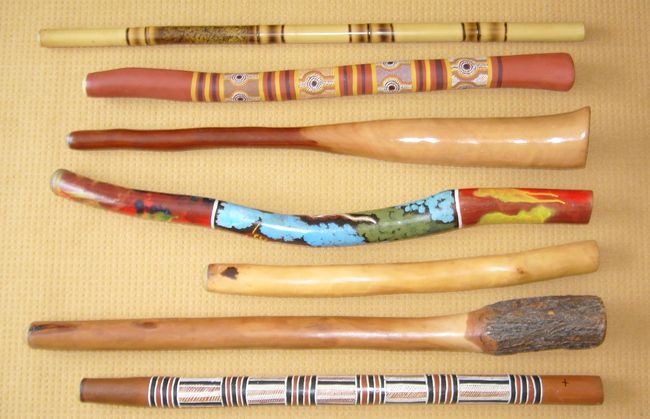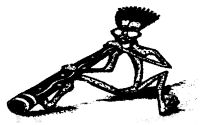Didgeridoo; under the spell of the primal hum
Didgeridoo is a western name for perhaps the oldest wind instrument on earth. The
names given to it by the Australian aborigines include: yedaki, gunbarr, yeraki,
yigi-yigi and djalapu. That depends on the clan to which the aborigines belong.
The Aborigines have probably played this unique wind instrument for more than 40,000
years, especially during feasts, dedications, funerals and sacred ceremonies.
Hollow tree trunk
The instrument is generally made from a trunk or branch of the eucalyptus tree and is
about 120-160 cm long. Termites have eroded these living trees. The aborigines tailor
the didgeridoo, knock out the brittle contents, paint it and put a beeswax mouthpiece
on it. The paintings mainly consist of "dreamings" of the Aborigines, i.e.
representations of snakes, lizards, kangaroos, turtles or other totem animals.
There are also bamboo and PVC didgeridoos; a sliding didgeridoo has even been designed.
 |
Some didgeridoos |
How to play?
The basis of the didgeridoo's sound is the tonic. This is achieved by blowing into the
mouthpiece with vibrating lips. In addition, a special blowing technique is used, the
so-called circular breathing. The circular breath is used to continue playing a
continuous root note. You have to inhale and blow at the same time.
Like no other musical instrument, it is possible to put yourself in the music.
There is no sheet music and the limits of the instrument are the limits of the player.
Breathing well is relaxing and being relaxed is healthy!
Making music (= fun) in general has a beneficial effect.
The instrument can be played solo, but also with several didgeridoos at the same
time. The didgeridoo is often used as an accompaniment for singing and dancing.
As a solo instrument, the didgeridoo is used to tell stories. These are the
"dreamings" of the aborigines. The instrument then imitates the sounds
that occur in daily life. They are mostly sounds from nature: like a jumping kangaroo,
the hum of the earth, a howling dingo, the snarling monitor lizard, the laughing
kookaburra, an impending thunderstorm and even annoying flies. Words can also be
formed, pronounced or sung while playing in the instrument. Even using a head voice
is possible.
Rules
For the aboriginal, the instrument is a way of making contact with his ancestors;
it is a sacred instrument and should only be played by one who is initiated for it.
But those are the rules that apply in Australia.
For many years there have been many aboriginal didgeridoo players who came to Europe
in the summer to spread their knowledge of the instrument. They regularly gave concerts
and workshops.
David Hudson, a well-known didgeridoo player from Australia, said during a concert
in Bruges in Belgium: if you are in Australia, you must follow our rules with the
didgeridoo.
What you do here in Europe is your business. With that he gave us the freedom in
Europe to do with the instrument as we see fit, but .....
it is a sacred instrument for the aborigines. It is, as it were, a magical instrument.
This means: what you radiate, you attract. Or also, if you play the instrument with
good intentions, then no crazy things can happen.
There are more rules associated with a magic instrument:
do not play didgeridoo if you have consumed alcohol;
don't play at someone's head, because then you create chaos;
it is not wise to listen to didgeridoo music through headphones.
 |
Sliding didge - didjeribone (Charlie McMahon) |
Healing effect
If you are touched by the sound of the didgeridoo, playing is more than just
making music. It calms you down. The sounds of the instrument work in a miraculous
way. Playing the didgeridoo has a beneficial effect, for both the player and the listener.
The aborigines are very taciturn about the effects of playing on the didgeridoo;
it's their secrets.
The length and content of the didgeridoo generally determine the pitch of the instrument.
It is known from the chakra teachings that each chakra (energy center of the body)
has a pitch:
Chakra |
Pitch |
Positive Effects |
|---|---|---|
Crown chakra |
B |
Connection with your higher self |
Forehead chakra |
A |
Insight into your life |
Throat chakra |
G |
Express yourself |
Heart chakra |
F |
Connecting yourself to the world around you |
Solar plexus |
E |
Standing up for yourself, stimulates your feeling |
Spleen Chakra |
D |
Stimulates your creativity |
Root chakra or base chakra |
C |
Works grounding, gets you out of your thinking |
With this knowledge there is more insight into the effects of a didgeridoo.
Anyone purchasing a didgeridoo for the first time would be wise to start with a
didgeridoo in C.
 |
Didjeridoo player |
